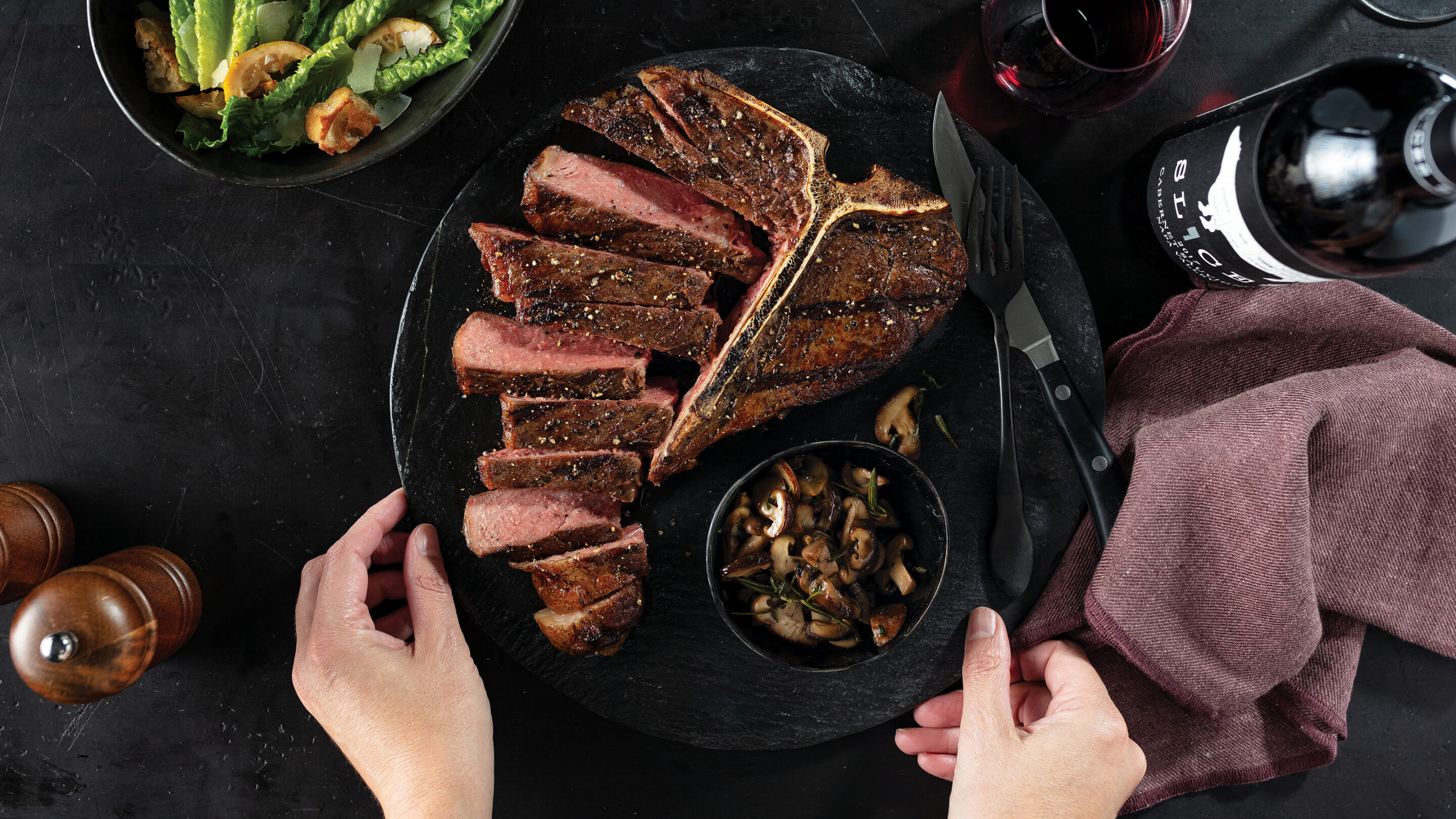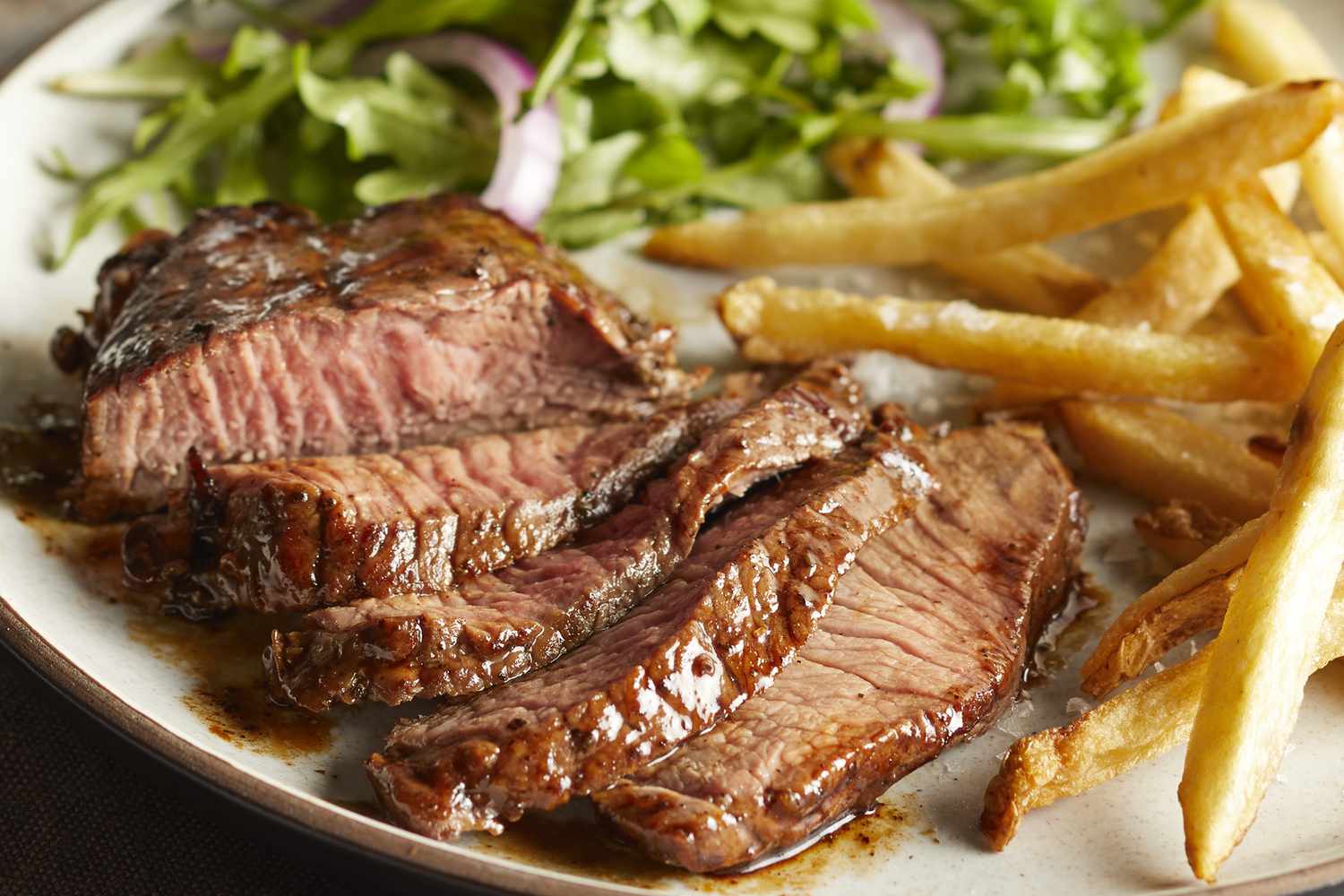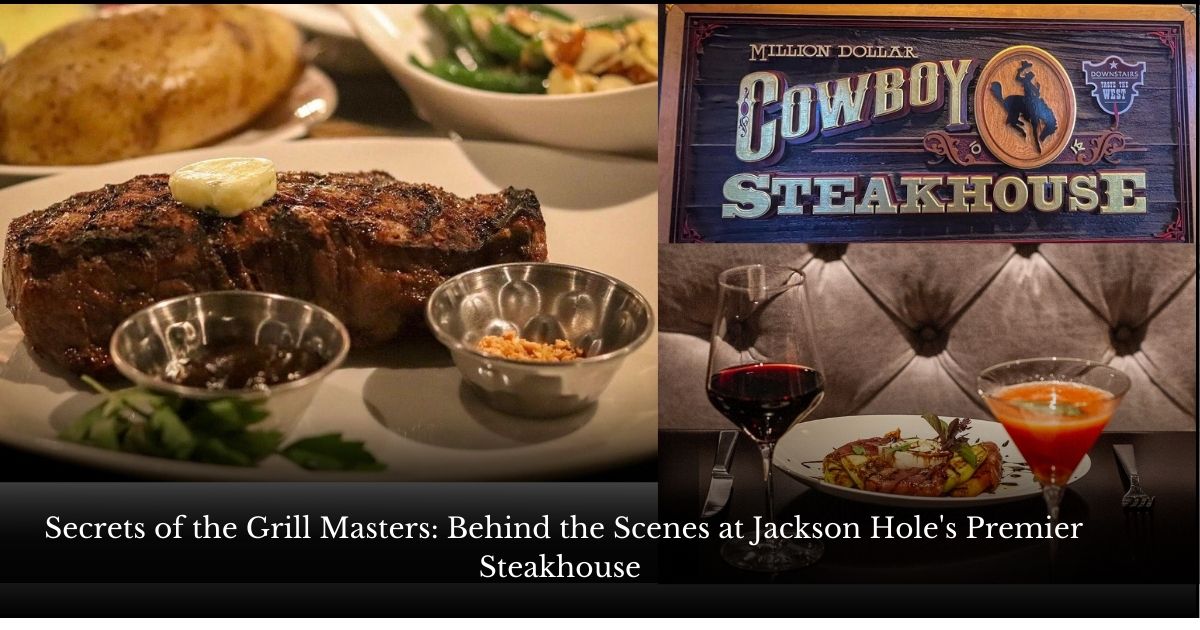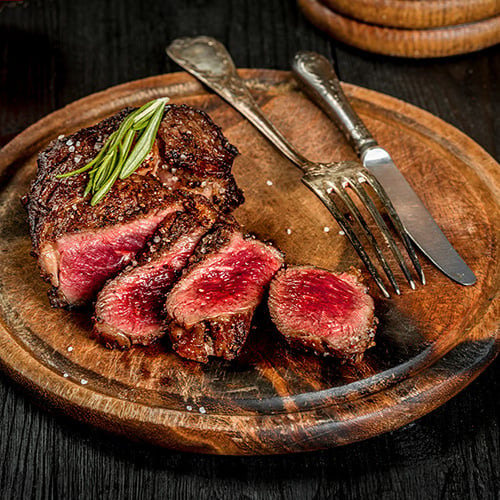To cook bison steak, start by seasoning the steak with salt, pepper, and your choice of herbs. Next, preheat the grill or skillet to medium-high heat.
For a medium-rare steak, cook for about 5-7 minutes per side. Before slicing and serving, allow the steak to rest for a few minutes. the cook Bison steak is a flavorful and lean alternative to traditional beef, offering a unique dining experience. If you’ve never cooked bison steak before, you may be wondering how to prepare it to achieve the best results.
Whether you’re a seasoned chef or an amateur cook, mastering the art of cooking bison steak will elevate your culinary skills and impress your dinner guests. In this guide, we’ll explore the step-by-step process of cooking bison steak, covering everything from seasoning to grilling techniques to ensure a delicious and tender outcome.

Credit: www.omahasteaks.com
Selecting The Right Bison Steak
Cooking bison steak is a delightful experience, offering a lean and flavorful alternative to traditional beef. Before you fire up the grill or heat the skillet, it’s crucial to choose the right cook bison steak to ensure a delicious dining experience. Selecting the right to cook bison steak involves considering the cut and grade, which plays a significant role in the outcome of your cooking efforts.
Choosing The Cut
When choosing to cook bison steak, it’s essential to understand the different cuts available. Ribeye, New York strip, filet mignon, and sirloin are popular options. Ribeye offers a balance of marbling and tenderness, while New York strip provides a robust flavor. The filet mignon, known for its tenderness, and the sirloin, a versatile cut, also offer unique dining experiences.
- Ribeye: Balance of marbling and tenderness
- New York strip: Robust flavor
- Filet mignon: Extra tenderness
- Sirloin: Versatile cut with a distinct flavor
Considering The Grade
The grade of bison steak refers to its quality based on factors such as marbling, tenderness, and flavor. When selecting to cook bison steak, it’s important to consider the grade. Prime -cook bison steak is the highest grade, offering abundant marbling and exceptional tenderness, while choice and select grades provide varying levels of marbling and tenderness.
- Prime: Abundant marbling and exceptional tenderness
- Choice: Varying levels of marbling and tenderness
- Select: Basic marbling and tenderness

Credit: recipes.net
Preparing The Bison Steak
Now that you have your cooked bison steak ready, it’s time to prepare it for cooking. Properly thawing and marinating the meat are crucial steps that can enhance its flavor and tenderness.
Thawing And Marinating
Thawing the cook bison steak is the first step towards achieving a juicy and delicious result. To ensure even thawing, place the steak in the refrigerator for approximately 24 hours. Remember to remove it from the freezer and unwrap it before placing it in the fridge. Patience is key here, as rushing the thawing process can lead to unevenly cooked meat.
Once the cook bison steak is fully thawed, it’s time to marinate it. Marinating aids in tenderising the meat in addition to adding flavour. Choose a marinade that complements the natural richness of bison and allows its fantastic taste to shine through. A simple yet effective marinade can be prepared using olive oil, minced garlic, freshly squeezed lemon juice, and a pinch of salt and pepper.
Seasoning For Flavor
Now that your cook bison steak has been thawed and marinated, it’s time to season it with a flavorful blend of spices. A well-seasoned steak can take your dish to new heights in terms of taste. Keep in mind that bison meat has a bold flavor profile, so choose seasonings that can complement its natural taste rather than overpowering it.
To start, sprinkle a generous amount of salt and pepper on both sides of the steak. You can also incorporate additional spices like garlic powder, paprika, or dried herbs to further enhance the flavor. Remember that seasoning is subjective, so feel free to experiment and adjust the spices according to your personal preference.
Once the seasonings have been applied, gently press them onto the surface of the steak to ensure they adhere well. This will help the flavors penetrate the meat and create a flavorful crust when cooked.
Pro tip: Allow the seasoned steak to rest at room temperature for approximately 30 minutes before cooking. This will help the meat cook more evenly and retain its juices.
By following these simple steps of thawing, marinating, and seasoning, you are now ready to cook your perfectly prepared bison steak to enjoy its tenderness and rich flavor. Remember, proper preparation is the key to a memorable dining experience!
Mastering The Grilling Process
Learn the secrets of mastering the grilling process for cooking the perfect bison steak. Discover the best techniques and tips to achieve a flavorful and tender result every time. Elevate your grilling game and impress your guests with a delicious bison steak cooked to perfection.
Preheating The Grill
Before you start grilling your bison steak, it’s essential to preheat the grill properly. Preheating your grill ensures that the steak cooks evenly, seals in the juices, and develops a delicious crust on the outside.Begin by cleaning the grill grates and removing any leftover food residues. Then, light the grill and set it to medium-high heat. Allow it to heat up for about 10-15 minutes, or until it reaches a temperature of around 400°F (204°C).While the grill is preheating, take your bison steak out of the refrigerator, allowing it to come to room temperature for around half an hour. This step helps the meat cook more evenly on the grill.
Grilling To Perfection
Grilling bison steak is all about achieving that perfect balance between a tender inside and a flavorful charred exterior. Follow these simple steps to master the grilling process:
- Pat the bison steak dry with paper towels to remove any excess moisture. This helps the steak to sear properly on the grill.
- Season the steak generously with your favorite dry rub or marinade. Allow the flavors to penetrate the meat by letting it sit for at least 15 minutes (or longer if you have the time).
- Place the bison steak on the preheated grill at a 45-degree angle to create those beautiful grill marks. Close the lid and grill for about 4-6 minutes for medium-rare steak, turning it halfway through to ensure even cooking.
- Use a meat thermometer to check the internal temperature of the steak. For medium-rare, it should read 130-135°F (54-57°C). Remember to insert the thermometer into the thickest part of the steak without touching the bone.
- Once the steak reaches your desired doneness, remove it from the grill and let it rest for 5-10 minutes on a cutting board. This allows the juices to redistribute and makes for a more tender and flavorful steak.
- Finally, slice your bison steak against the grain, serve it with your favorite side dishes, and enjoy a delicious and perfectly grilled meal.
Remember, grilling bison steak takes practice, so don’t be discouraged if it’s not perfect the first time. Add your own personal touch by experimenting with different seasonings and techniques, and soon you’ll be grilling bison steak to absolute perfection.

Credit: milliondollarcowboysteakhouse.com
Achieving The Ideal Bison Steak Doneness
When it comes to cooking a bison steak, achieving the ideal level of doneness is crucial for a mouthwatering dining experience. Unlike other types of meat, bison has lower fat content, which means it can become tough and dry if overcooked. To ensure you cook your bison steak to perfection, follow these simple guidelines.
Using A Meat Thermometer
Using a meat thermometer is essential when cooking bison steak to achieve the desired doneness. This handy tool allows you to monitor the internal temperature of the meat accurately. To use a meat thermometer:
- Insert the thermometer into the thickest part of the steak, avoiding the bone.
- Make sure the thermometer does not touch the pan or grill, as this could give you an inaccurate reading.
- Leave the thermometer in place until it displays the appropriate internal temperature.
Remember, different levels of doneness correspond to different internal temperatures. The following are the recommended temperatures for bison steak:
| Doneness | Internal Temperature |
| Rare | 125°F (51.6°C) |
| Medium Rare | 135°F (57.2°C) |
| Medium | 145°F (62.8°C) |
| Medium Well | 155°F (68.3°C) |
| Well Done | 165°F (73.9°C) |
Resting The Steak
Resting the steak after cooking is a crucial step in achieving the ideal doneness. The liquids can redistribute during resting, making the steak more delicious and tender. Here’s what you need to do:
- Once the bison steak reaches your desired internal temperature, remove it from the heat source.
- Transfer the steak to a cutting board and loosely cover it with foil.
- Let the steak rest for at least 5 minutes to allow the juices to settle and the steak to reach its final temperature.
Remember, the steak will continue to cook slightly during the resting period, so bear this in mind when determining the ideal internal temperature.
Serving And Enjoying The Bison Steak
Savor the succulent flavors of bison steak by grilling it to a perfect medium-rare. Season with a blend of herbs and spices for an unforgettable culinary experience. Visit our website for step-by-step bison steak recipes and cooking tips.
Now that your deliciously cooked bison steak is ready to be served, it’s time to enhance your dining experience with the perfect accompaniments and flavors. From garnishing and sides to pairing it with the right wine or beer, here are some tips to elevate your bison steak to a whole new level.
Garnishing And Sides
When it comes to garnishing your bison steak, simplicity is key. A few fresh herbs or a sprinkle of sea salt can go a long way in enhancing the natural flavors of the meat. Consider garnishing your steak with a sprig of rosemary or thyme, or even a drizzle of flavored butter for an added burst of richness.
To complement the robust taste of the bison steak, choose sides that are equally delicious. Roasted vegetables like carrots, asparagus, or Brussels sprouts make a perfect choice. For a heartier option, consider pairing your steak with creamy mashed potatoes or a flavorful risotto. The contrast between the tender meat and the sides will create a harmonious dining experience.
Pairing With Wine Or Beer
Now, let’s talk about the perfect beverages to complement your bison steak. When it comes to wine, opt for bold reds with enough structure to stand up to the rich flavors of the meat. Cabernet Sauvignon or Malbec are excellent choices, with their full-bodied profiles and notes of dark fruits and spices.
If you prefer beer, reach for a robust porter or stout. These darker beers have caramel and roasted flavors that pair exceptionally well with the bison steak. The effervescence of the beer will cleanse your palate and enhance the flavors of the meat with each sip.
To summarize, garnishing your bison steak with fresh herbs and a pinch of sea salt can add a delightful touch, while roasted vegetables or creamy mashed potatoes make for delicious sides. For a perfect beverage pairing, choose a bold red wine like Cabernet Sauvignon or a robust porter or stout if you prefer beer. Elevate your bison steak experience with these simple yet satisfying serving tips.
Frequently Asked Questions For How To Cook Bison Steak
How Long Does It Take To Cook A Bison Steak?
A bison steak typically takes 8-10 minutes to cook to medium-rare. Remember to preheat your grill or skillet, and let the steak rest for a few minutes after cooking to ensure maximum juiciness.
What Is The Best Way To Season A Bison Steak?
For a delicious flavor, season your bison steak with a simple blend of salt, pepper, and garlic powder. You can also add a hint of herbs like rosemary or thyme for extra aroma.
Can I Marinate A Bison Steak?
Yes, marinating a bison steak is a great way to enhance its tenderness and flavor. Choose a marinade with acidic ingredients like vinegar or citrus juice, and let the steak marinate for at least 2 hours or overnight for optimal results.
How Do I Know When A Bison Steak Is Cooked To My Liking?
To check the doneness of your bison steak, use a meat thermometer. The interior temperature should be 135°F (57°C) for medium-rare. Remember that the steak will continue cooking as it rests, so remove it from heat slightly before reaching the desired temperature.
Conclusion
Cooking bison steak is a delicious and nutrient-rich alternative to traditional beef. By following these simple steps, you can achieve a perfectly cooked bison steak every time. Remember to choose a good quality cut, properly season and marinate the meat, and be mindful of cooking times to ensure a tender and flavorful result.
So, the next time you’re in the mood for a mouthwatering steak, give bison a try and savor the unique flavors it has to offer. Happy cooking!

I am a cooking writer and blogger based in the USA. I have over 4 years of experience writing about the latest trends and innovations in cooking.
with a focus on topics like cooking recipes, how to cook, healthy cooking, and cooking classes.

